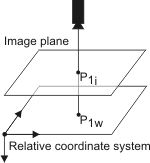McalTransformCoordinate
| MIL_ID CalibrationOrImageId, | //in |
| MIL_INT64 TransformType, | //in |
| MIL_DOUBLE X, | //in |
| MIL_DOUBLE Y, | //in |
| MIL_DOUBLE *ResXPtr, | //out |
| MIL_DOUBLE *ResYPtr | //out |
This function converts a pair of coordinates from their pixel value to their world value (or vice versa). The conversion can be performed according to a calibration context, calibrated image, or corrected image.
Note that, if you changed the origin and/or orientation of the relative coordinate system (using McalRelativeOrigin() or McalSetCoordinateSystem()), world coordinates will be returned, or assumed to be given, with respect to this relative coordinate system.
This function converts the coordinates of a point by making a line connecting the center of the camera's lens with the point provided, and then finding the intersection of that line with the required plane. To convert an image pixel to a world point, this function defines a line connecting the center of the camera's lens with the image plane, and then returns the intersection of this line with the world plane.

However, if the image plane is not parallel to the relative coordinate system, due to the camera setup or a displacement of the relative coordinate system, not every point in the image plane will have a valid real-world equivalent. Three types of intersections can occur when transforming from the image plane to the world plane. If the specified point in the image plane corresponds to a point in front of the camera and in the relative coordinate system, that point in the relative coordinate system is returned. However, if the line traced through the specified point in the image plane does not intersect the XY (Z=0) plane of the relative coordinate system, M_INVALID_POINT is returned since there is no intersection. If the line's intersection with the XY (Z=0) plane of the relative coordinate system is behind the camera, then the mathematically computed value is returned, even though it is not the correct world location of the point specified in the image.
However, using M_NO_POINTS_BEHIND_CAMERA returns M_INVALID_POINT if the returned point is behind the camera.
Specifies the identifier of the calibration context, calibrated image, or corrected image.
If you are transforming coordinates obtained from a calibrated image, you can either pass the identifier of the image or that of its calibration context. However, if the coordinates are obtained from a child buffer, you must pass the identifier of the child buffer.
Specifies whether to perform a pixel-to-world or world-to-pixel conversion. This parameter must be set to one of the following values:
 For specifying pixel-to-world or
world-to-pixel
For specifying pixel-to-world or
world-to-pixel |
|||||||||||||||||||||||||||||||||||||||
  Value Value |
Description
|
||||||||||||||||||||||||||||||||||||||
  M_PIXEL_TO_WORLD + M_PIXEL_TO_WORLD + |
Converts from pixel to world. |
||||||||||||||||||||||||||||||||||||||
  M_WORLD_TO_PIXEL + M_WORLD_TO_PIXEL + |
Converts from world to pixel. |
||||||||||||||||||||||||||||||||||||||
You can add one of the following values to the above-mentioned values to specify the return of invalid points.
 For specifying to return invalid
points
For specifying to return invalid
points |
|||||||||||||||||||||||||||||||||||||||
  Combination value Combination value |
Description
|
||||||||||||||||||||||||||||||||||||||
  M_NO_EXTRAPOLATED_POINTS M_NO_EXTRAPOLATED_POINTS |
Specifies that if a pixel involved in the transformation is not inside the calibrated region, M_INVALID_POINT will be returned, instead of a coordinate resulting from the extrapolation. (more details...) |
||||||||||||||||||||||||||||||||||||||
  M_NO_POINTS_BEHIND_CAMERA M_NO_POINTS_BEHIND_CAMERA |
Specifies that M_INVALID_POINT is returned when a computed point is mathematically valid but physically impossible (behind the camera). (more details...) |
||||||||||||||||||||||||||||||||||||||
Specifies the address of the variable in which to place the returned value of the X-coordinate. One of the following can be written to the address.
 For specifying the potential return
values of the X-coordinate
For specifying the potential return
values of the X-coordinate |
|||||||||||||||||||||||||||||||||||||||
  Value Value |
Description
|
||||||||||||||||||||||||||||||||||||||
   M_INVALID_POINT M_INVALID_POINT |
Specifies a non-valid coordinate. |
||||||||||||||||||||||||||||||||||||||
 
 Value Value |
Specifies the transformed X-coordinate as a value. |
||||||||||||||||||||||||||||||||||||||
Specifies the addres of the variable in which to place the returned value of the Y-coordinate. One of the following can be written to the address.
 For specifying the potential return
values of the Y-coordinate
For specifying the potential return
values of the Y-coordinate |
|||||||||||||||||||||||||||||||||||||||
  Value Value |
Description
|
||||||||||||||||||||||||||||||||||||||
   M_INVALID_POINT M_INVALID_POINT |
Specifies a non-valid coordinate. |
||||||||||||||||||||||||||||||||||||||
 
 Value Value |
Specifies the transformed Y-coordinate as a value. |
||||||||||||||||||||||||||||||||||||||
| Header | Include mil.h. |
| Library | Use mil.lib; milcal.lib. |
| DLL | Requires mil.dll; milcal.dll. |